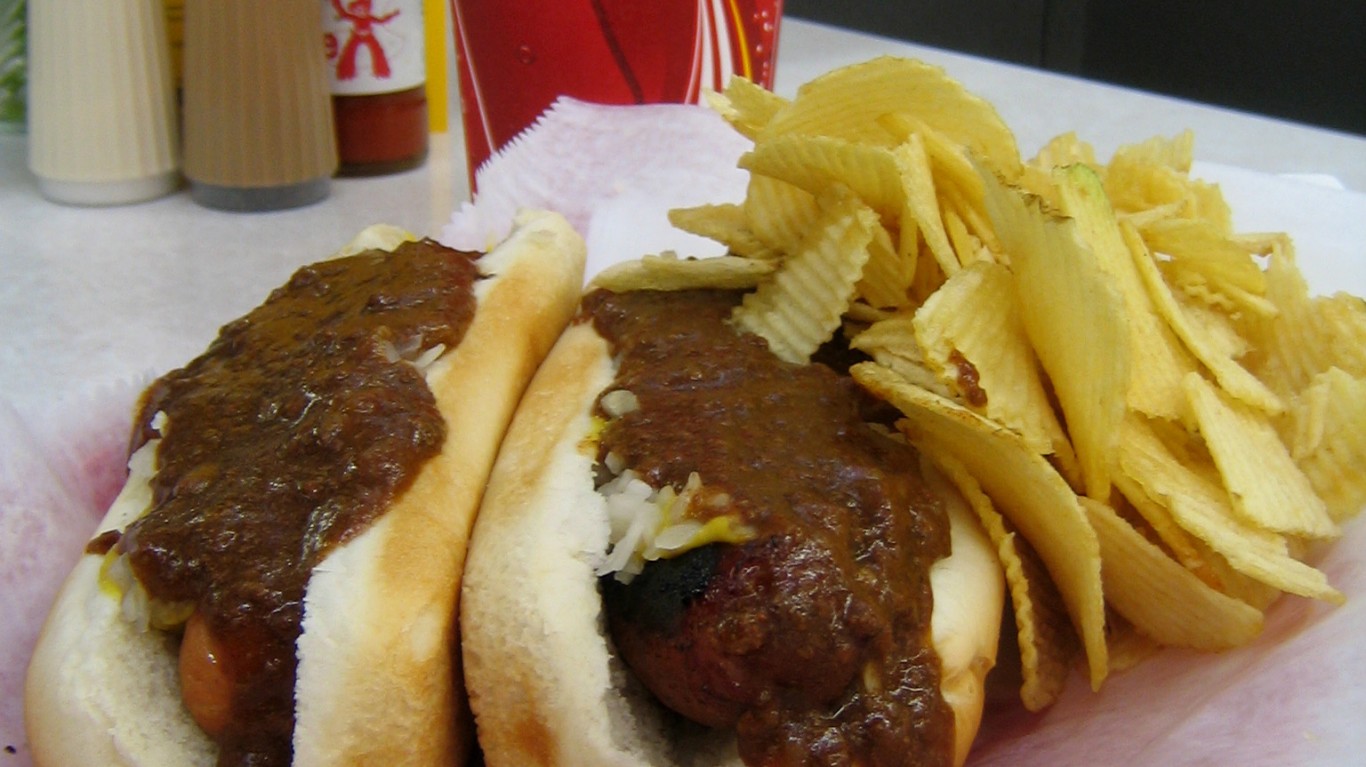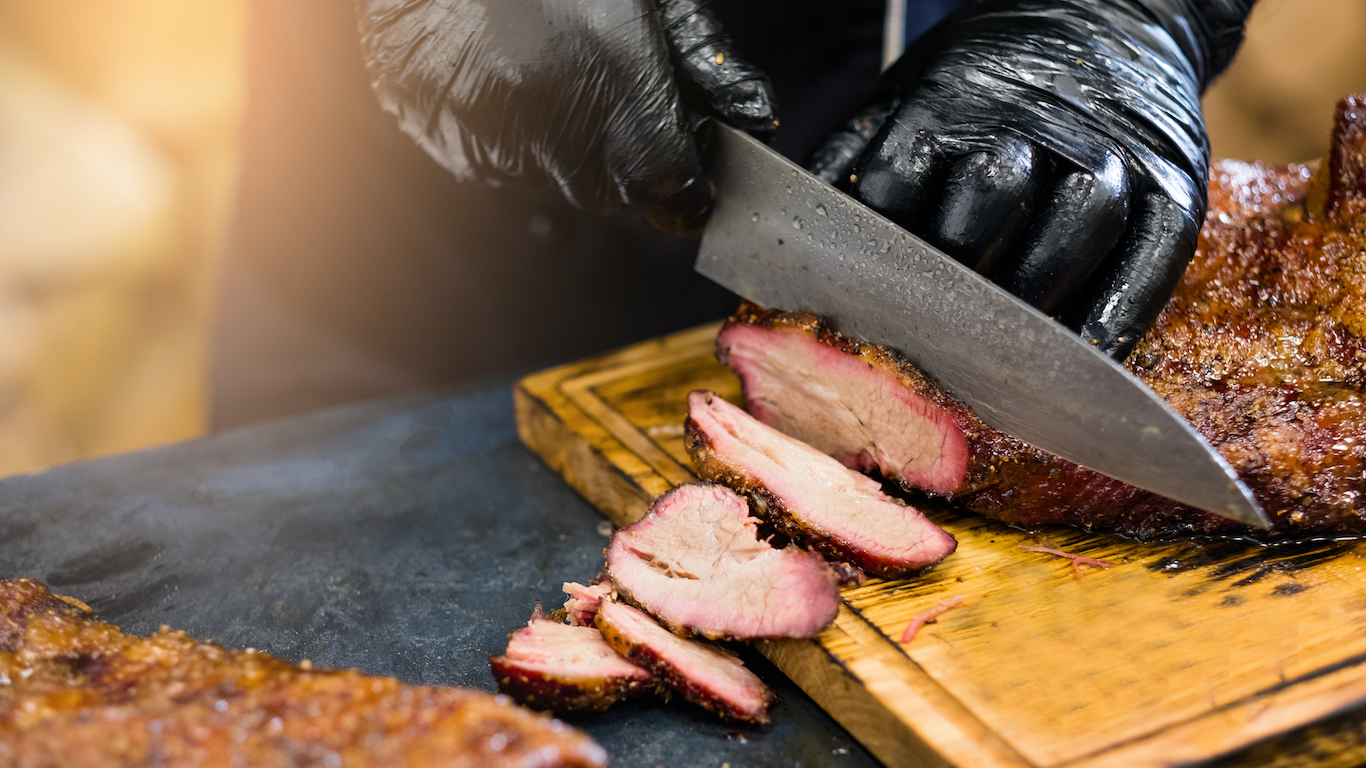
Food snobs and scholars may debate whether or not there’s such a thing as American cuisine. A distinguished Yale history professor has even written a book on the subject.
What can’t be denied is that, whether or not they amount to a cuisine, we have a number of iconic dishes — burgers, fried chicken, apple pie, enthusiastically adopted imports like tacos and pizza, and more. These are foods that reflect our melting-pot origins and signal our appreciation for fare that’s flavorful and unpretentious — comforting, it might be said. (These are America’s favorite comfort foods.)
But America is huge, almost the same size as all of Europe combined. And while there may be dishes that are common across the land, we can also boast a treasury of local specialties indelibly identified with one small corner of the country or another, or even a single city.
24/7 Tempo has consulted scores of civic and regional websites and online food history resources to identify the signature dishes from 50 American municipalities, from coast to coast and border to border. These range from our biggest cities — like New York, Los Angeles, and Chicago — to such tiny towns as Freeman, South Dakota, and Madison, Minnesota.
Click here to see signature dishes from 50 American cities and towns
Some of these emblematic foods have become nationwide favorites, like Buffalo wings, bagels, and Key lime pie. Others remain little known outside their birthplaces. The average American, for instance, is unlikely to have heard of chislic, kringles, or the Horseshoe Sandwich.
In some cases, these signature dishes might sound familiar — varieties of barbecue or the aforementioned pizza, for instance — but they’re made with local twists that give them a unique identity. Others might sound a bit peculiar. (Here are the strangest foods from every state.)
All of these signature dishes, though, whether they’ve become famous nationally or remain known and appreciated only in their hometowns, are expressions of America’s diversity and individuality. They’re also well worth trying if you’re on their native ground.

Atlantic City, New Jersey
> Signature: Saltwater candy
Soft candy, invented in Atlantic City in the 1880s and strongly identified with that city’s Boardwalk. It contains no saltwater, and may have gotten its name after a stock of the candy was inundated during a storm in 1883.
[in-text-ad]

Baltimore
> Signature: Crab cake
Crab meat formed into patties with cracker or bread crumbs and spices. The term “crab cakes” was first used in the 1930s. Other Baltimore signatures: whole steamed blue crabs to be cracked with mallets on a newspaper-covered table; pit beef sandwiches (smoky thin-sliced roast beef on a bun).

Binghamton, New York
> Signature: Spiedies
Marinated cubes of lamb (originally), beef, pork, chicken, or venison grilled on metal skewers (“spiedie” comes from the Italian “spiedo,” skewer or spit) and served on an Italian roll. Spiedies were first made by Italian immigrants in Binghamton in the 1920s.

Boston
> Signature: Baked beans
Navy beans or other small white beans slow-cooked with molasses and salt pork. The dish, which dates from Colonial times, is the source of Boston’s nickname, Beantown. Other Boston signatures: scrod, the local name for cod, haddock, or other firm white fish, traditionally baked with a bread crumb topping; clam chowder, the creamy kind, common all over New England but particularly associated with Boston; Parker House rolls, invented at the city’s Parker House Hotel.
[in-text-ad-2]
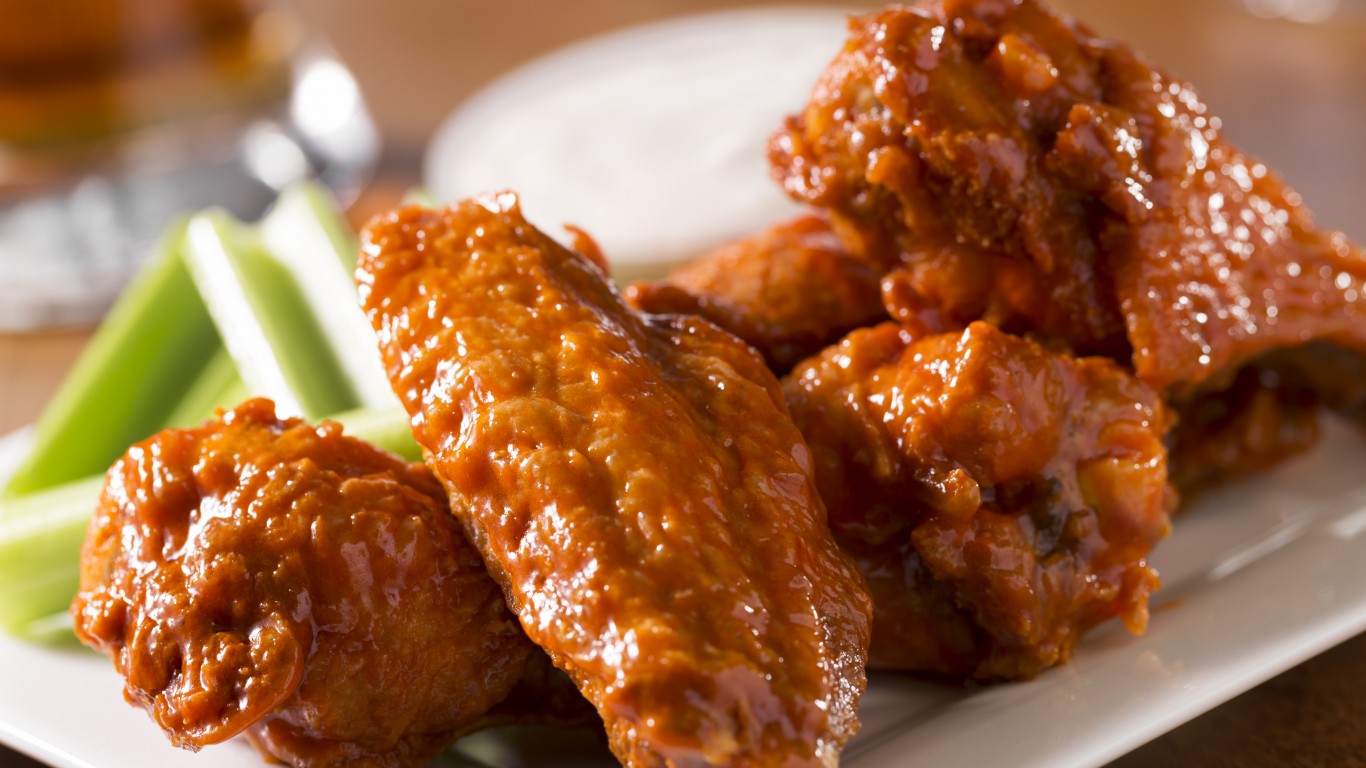
Buffalo, New York
> Signature: Buffalo wings
Deep-fried chicken wings glazed in hot sauce, served with celery and blue cheese dressing. Called simply “wings” in their hometown, the dish was invented in 1964 at the city’s Anchor Bar. Another Buffalo signature: beef on weck, thin-sliced roast beef with horseradish sauce on a Kummelweck roll (a kaiser-type roll topped with caraway seeds and coarse salt).
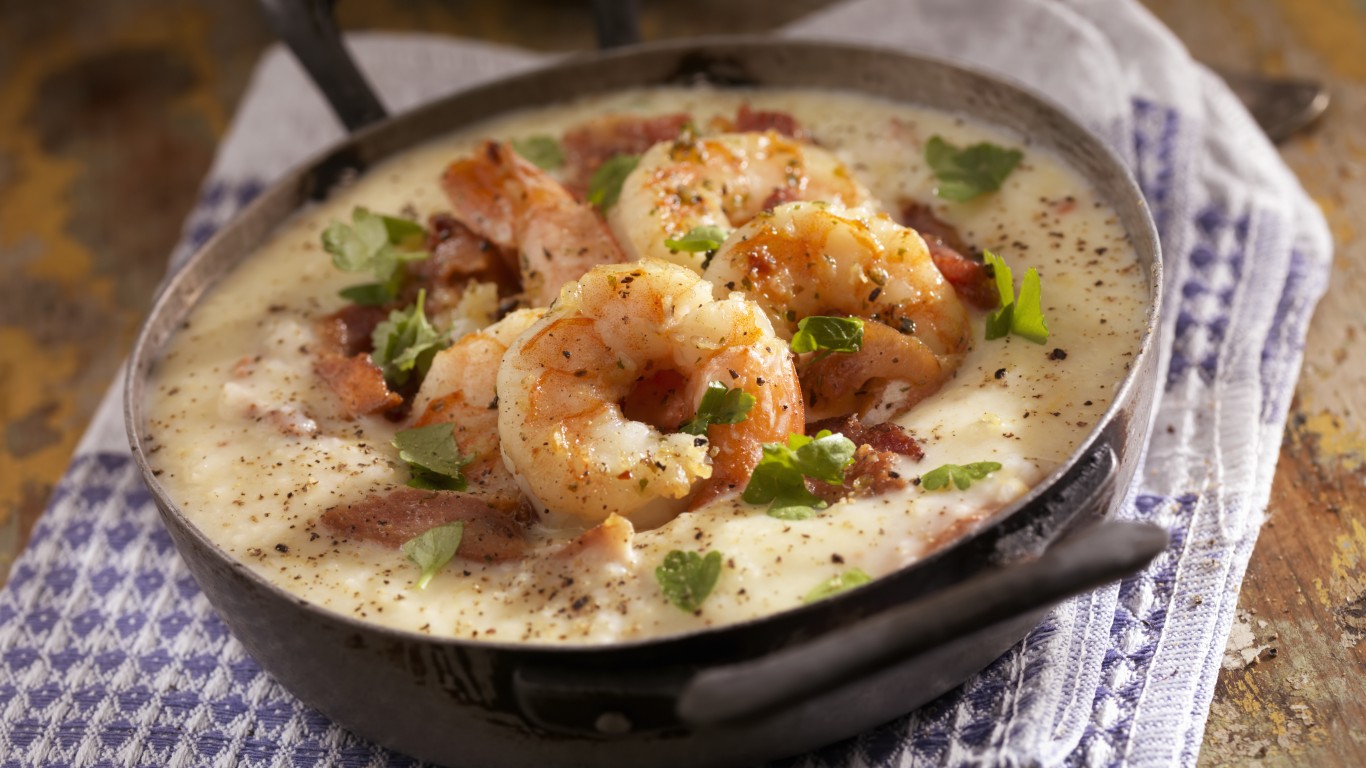
Charleston, South Carolina
> Signature: Shrimp and grits
Sauteed shrimp (originally freshwater Charleston river shrimp) served over grits (ground hominy, which is starchy corn treated with an alkali solution to remove the hulls); also called breakfast shrimp or just shrimp grits. Some recipes call for adding such vegetables as onions, jalapenos, green onions, or garlic to the grits, and grated cheddar cheese is often stirred in.
[in-text-ad]
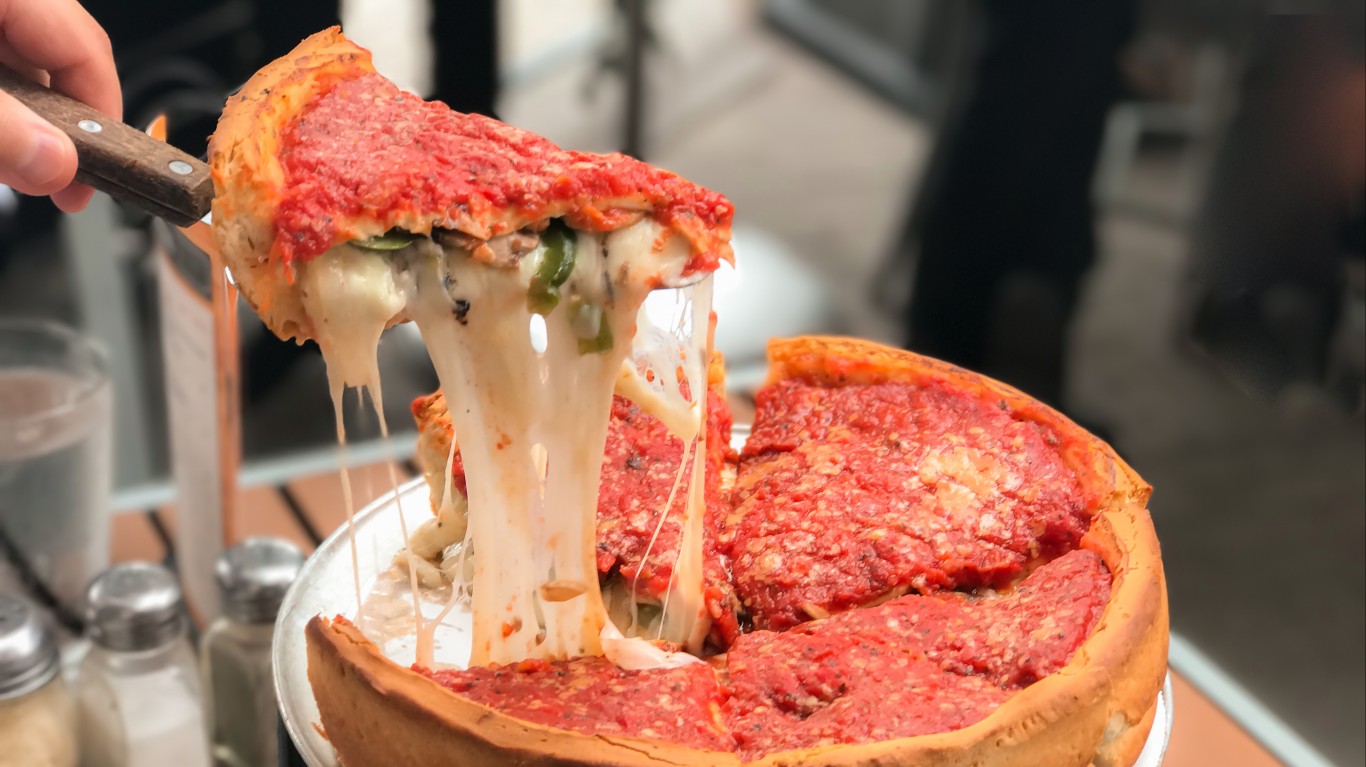
Chicago
> Signature: Deep-dish pizza DONE
More a pie than a conventional pizza, baked in a pan, with a deep crust filled with layers of cheese, meat and/or vegetables, and sauce; also called Chicago-style pizza. It was first served at the city’s Numero Uno pizzeria in 1943. Other Chicago signatures: Italian beef sandwich, not really Italian but a Chicago invention from the 1930s, made with shaved roast beef and vegetables on an Italian roll; Chicago-style hot dogs (steamed beef wieners loaded with five or six condiments on a poppy-seed bun).

Cincinnati
> Signature: Cincinnati chili
Not chili in the usual sense but a kind of ground meat sauce flavored with cinnamon and other spices, served over spaghetti and topped with various combinations of shredded cheese, onion, and beans. The chili was invented at a Cincinnati Greek restaurant run by Macedonian immigrants in 1922. Another Cincinnati signature: goetta, a German-style breakfast sausage made with pork, beef, oats, and spices.
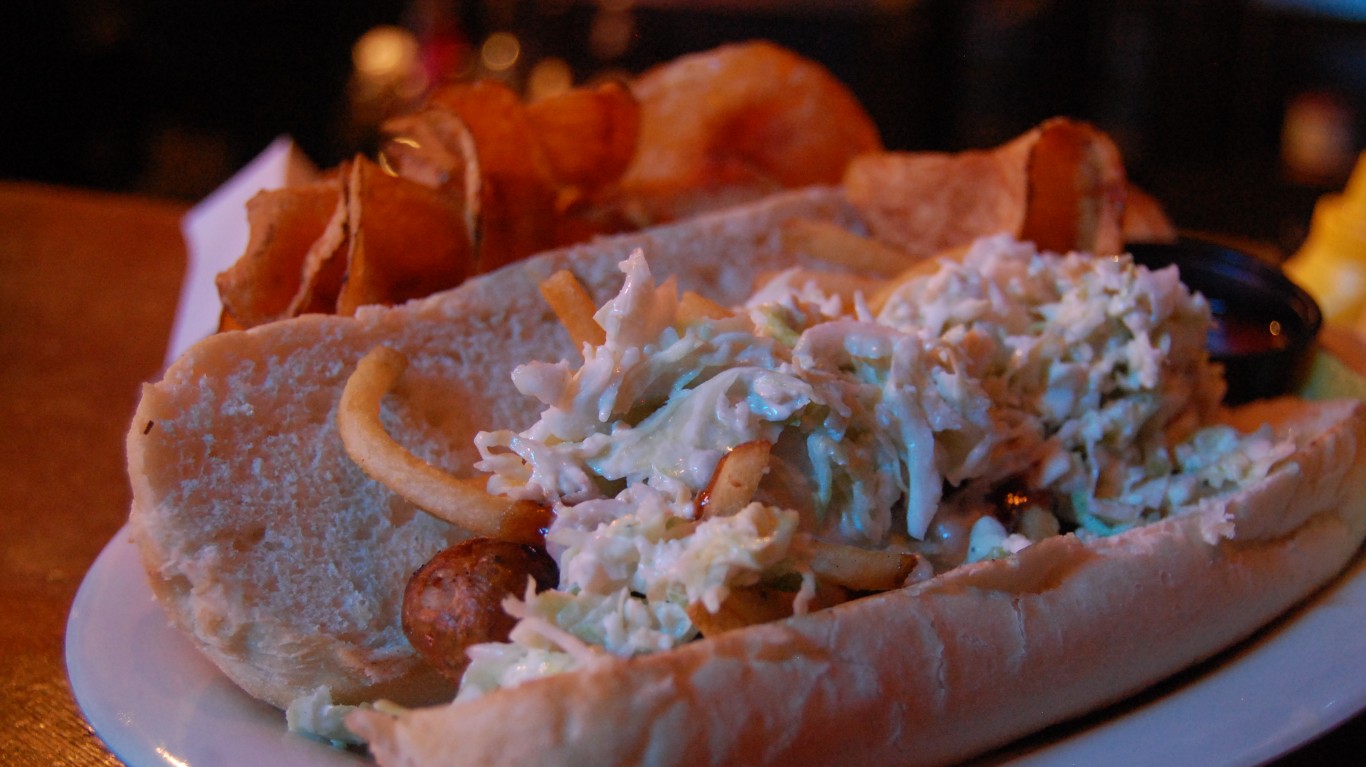
Cleveland
> Signature: Polish Boy
Kielbasa (a Polish-style sausage), French fries, coleslaw, and barbecue sauce on a bun. While its origins are obscure, it may have been invented at a local barbecue restaurant in the 1940s. One Cleveland restaurant serves a variation called the Drew Carey (the actor and game show host is a native of the city), which substitutes an all-beef hot dog for the kielbasa.
[in-text-ad-2]

Des Moines, Iowa
> Signature: Steak de Burgo
Steak (usually tenderloin) with butter, garlic, and herbs, sometimes in the form of a cream sauce. Possibly named after the Spanish city of Burgos and dating back to pre-World War II days, it has been called “a dish that is uniquely identified with Des Moines.”
Detroit
> Signature: Coney dog
A beef wiener in a steamed bun, topped with chili (no beans), diced onions, and yellow mustard. It was probably first made in the south-central Michigan city of Jackson, west of Detroit, in 1914, but arrived in Detroit a few years later and has become most strongly identified with that city.
[in-text-ad]

Evansville, Indiana
> Signature: Fried brain sandwich
Breaded and fried pig’s brain on a bun or toasted marble rye, garnished with pickles, onions, and mustard. It is said that the sandwiches were first made in St. Louis, about 150 miles northwest of Evansville, in the 1880s but became the signature offering of Evansville’s 1888-vintage Hilltop Inn.

Freeman, South Dakota
> Signature: Chislic
Cubes of marinated, salted lamb or other meat, usually deep-fried but sometimes grilled, served on skewers or impaled on toothpicks for snacking. Freeman, a small town southwest of Sioux Falls, South Dakota, is considered to be the central point in what has been called the Chislic Circle. The term “chiclic” is a variation on “shashlik” — Russian kebabs — and the dish is said to have been imported to South Dakota by Russian-German immigrants in the late 19th century.

Houston
> Signature: Phở
The emblematic Vietnamese beef soup with rice noodles; pronounced “fuh.” Houston has the nation’s third-largest Vietnamese population, and phở has become its latest signature dish. The Houston Chronicle proposed several years ago that the city was home to the best version of the soup in America.
[in-text-ad-2]

Kansas City, Missouri
> Signature: Barbecue
A style characterized by the use of many different meats, poultry, sometimes even fish, and by sweet barbecue sauces. The pioneer of KC barbecue was a pitmaster named Henry Perry in the early 1900s. The most famous purveyor in the latter 20th century was Arthur Bryant, whose restaurant was proclaimed by New Yorker writer (and Kansas City native) Calvin Trillin to be the best in the world.

Key West, Florida
> Signature: Key lime pie
A pie with a pastry or graham cracker crust filled with a sweet yellow custard flavored with Key lime juice. Key limes (also called West Indian or Mexican limes) were probably planted in Florida by the Spanish in the 1500s. The pie dates from the late 1800s, when it is said to have been created either by local fishermen or by a millionaire’s cook named Aunt Sally.
[in-text-ad]

Lafayette, Louisiana
> Signature: Plate lunch
Rice, meat of some kind (for instance, rabbit or short ribs), peppery gravy, two vegetable side dishes, and a piece of bread heaped onto one plate. It isn’t clear exactly when this specialty developed, but it is said to have grown out of the practice of Lafayette butchers to cook up miscellaneous meat scraps and drown them in gravy to feed local workmen at lunchtime.

Las Vegas
> Signature: All-you-can-eat buffet
Not a single dish but a signature style of eating — immense displays of self-serve foods of every kind, hot and cold. The first example of this phenomenon was a $1 “Buckaroo Buffet” created by the publicist at El Rancho Vegas, one of the first hotels on the strip, in the mid-1940s. Unfortunately, the COVID-19 pandemic has shut down self-service dining, at least for now, in Vegas as elsewhere around the country. Whether they will be revived, and if so in what form, is an open question at this point.

Lincoln, Nebraska
> Signature: Runza
Bread rolls enclosed around a filling of seasoned ground beef mixed with onions and cabbage, sometimes with other ingredients like cheese, bacon, and various vegetables. Runzas are based on the German stuffed rolls called Bierocks. They were developed in their present form by one Sally Everett, who opened a stand selling them in Lincoln in 1949. Everett subsequently trademarked the term Runza (based on a traditional name for them).
[in-text-ad-2]

Lockhart, Texas
> Signature: Barbecue
Primarily beef brisket (or sometimes the cut called shoulder clod) slow-cooked and smoked over wood fires for as long as 20 hours and traditionally seasoned with only salt and pepper. The style was developed by Czech and German immigrants to the Hill Country, near Austin and San Antonio, Texas, in the late 1800s. There are barbecue stands and restaurants all over the region. But Lockhart, in what are sometimes called the Hill Country foothills, boasts four of the best, and the state legislature has dubbed it the Barbecue Capital of Texas.
Los Angeles
> Signature: French dip sandwich
Thin-sliced roast beef or other meat on a long French roll whose cut sides have been dipped into roasting pan juices. The French dip was invented, apparently accidentally, by Parisian immigrant Philippe Mathieu at his sandwich shop in downtown L.A. in 1918. Other Los Angeles signatures: Cobb salad, a chopped salad made with lettuce, chicken, bacon, avocado, hard-boiled eggs, and other ingredients, invented at the Brown Derby restaurant in Hollywood in 1937; the patty melt, a burger on pan-fried rye bread with cheese and grilled onions, first made in the 1950s by L.A. restaurateur “Tiny” Naylor.
[in-text-ad]

Louisville, Kentucky
> Signature: The Hot Brown
An open-faced sliced turkey sandwich on toast, with bacon, tomatoes, and Mornay sauce (Béchamel sauce with shredded cheese melted in). The Hot Brown was invented by a chef at Louisville’s Brown Hotel in 1926. Other local restaurants serve it, too, but the Brown dining room is said to turn out about a thousand of the sandwiches every week.

Madison, Minnesota
> Signature: Lutefisk
Literally “lye fish,” dried cod or other firm white fish preserved with lye, soaked to remove the preservative, and steamed to flaky, gelatinous consistency. Definitely an acquired taste, lutefisk is a Scandinavian specialty particularly associated with Christmastime meals. Minnesota has the largest Scandinavian population of any state, and Madison — which styles itself the Lutefisk Capital of the World — claims the state’s highest per capita lutefisk consumption.
Memphis, Tennessee
> Signature: Barbecue
Primarily pork, especially pork ribs, which come either “dry” (coated in an herb and spice rub) or “wet” (basted with barbecue sauce); also pulled pork sandwiches. Barbecue is considered the city’s official cuisine, and there are said to be more than 100 barbecue places in town. The most famous one is Charlie Vergos’ Rendezvous, known for its dry ribs.
[in-text-ad-2]
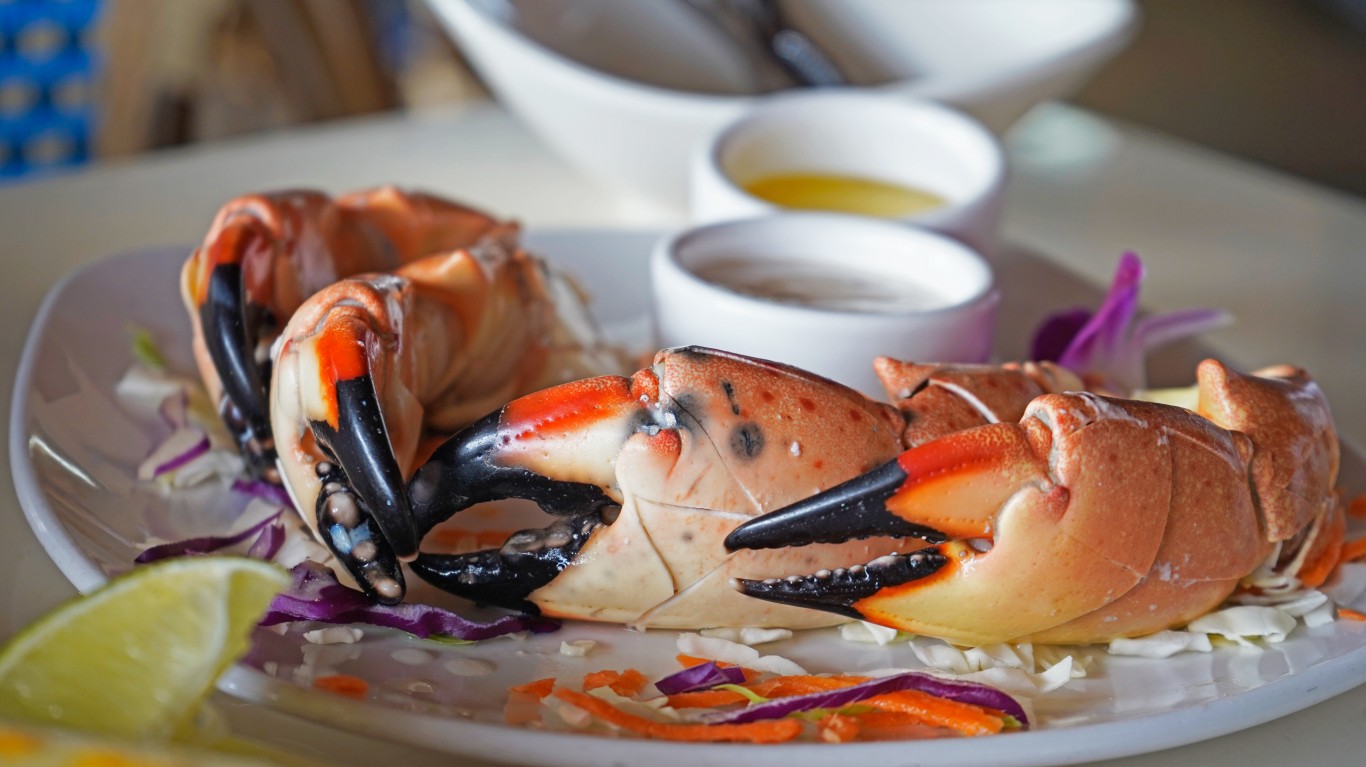
Miami
> Signature: Stone crab
A variety of Atlantic crab, found all along the Eastern Seaboard, noted for its meaty claws. The crabs were introduced to Miami (and the world) by Joe Weiss, who started serving the claws, boiled and chilled, at his Joe’s Restaurant in 1921. They were a hit, and he renamed his diner Joe’s Stone Crab. Other Miami signatures: Cuban sandwich (see Tampa, below); Key lime pie (see Key West, above).

Milwaukee
> Signature: Fried cheese curds
Pieces of curd left over from the cheesemaking process, battered and deep-fried. They have been described as “a staple in the diet of any true Milwaukeean.” Another Milwaukee signature: the cannibal sandwich, a piece of rye bread topped with chopped raw beef and chopped onion.
[in-text-ad]
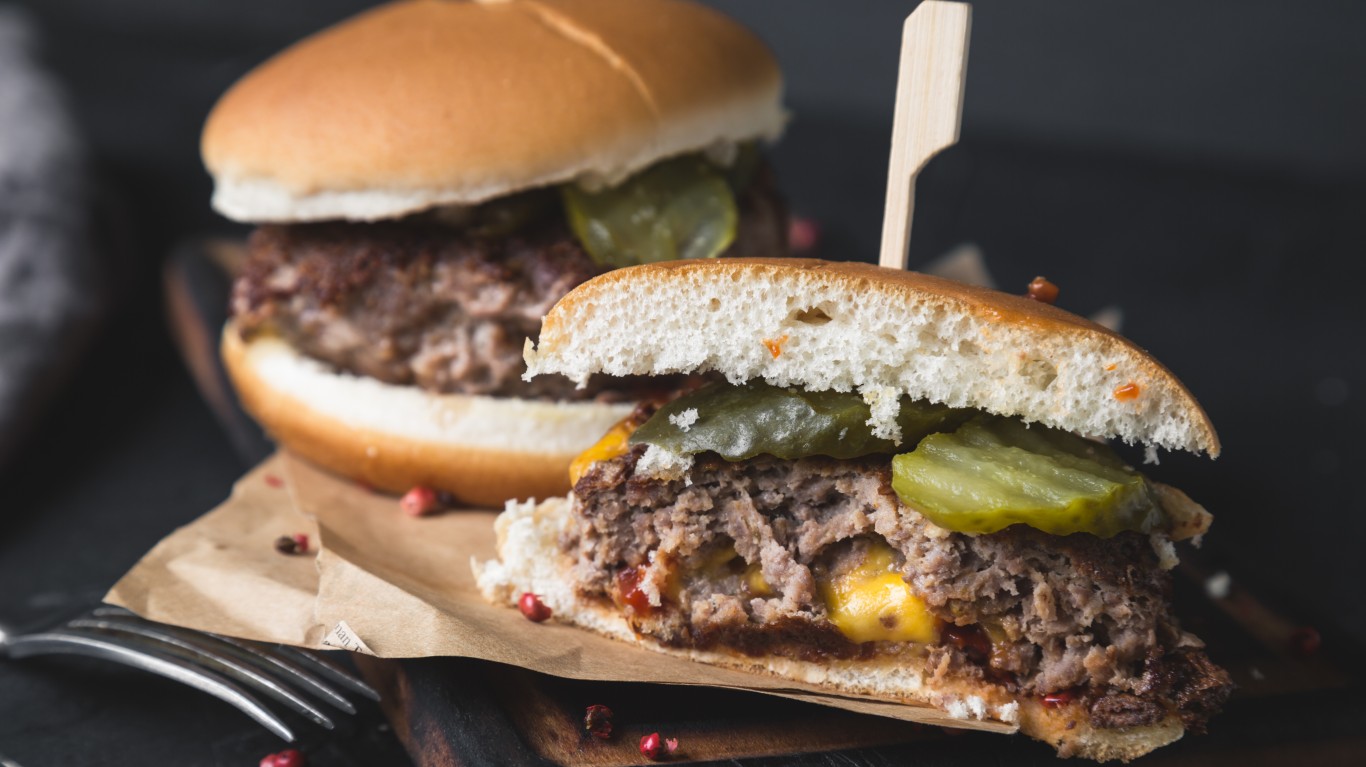
Minneapolis
> Signature: The Juicy Lucy
A cheeseburger with the cheese enclosed inside the patty so that it melts into liquid as the burger cooks. The Juicy Lucy was invented in a bar in south Minneapolis in the 1950s — either at the 5-8 Club or Matt’s Bar (which insists on spelling it “Jucy Lucy”).
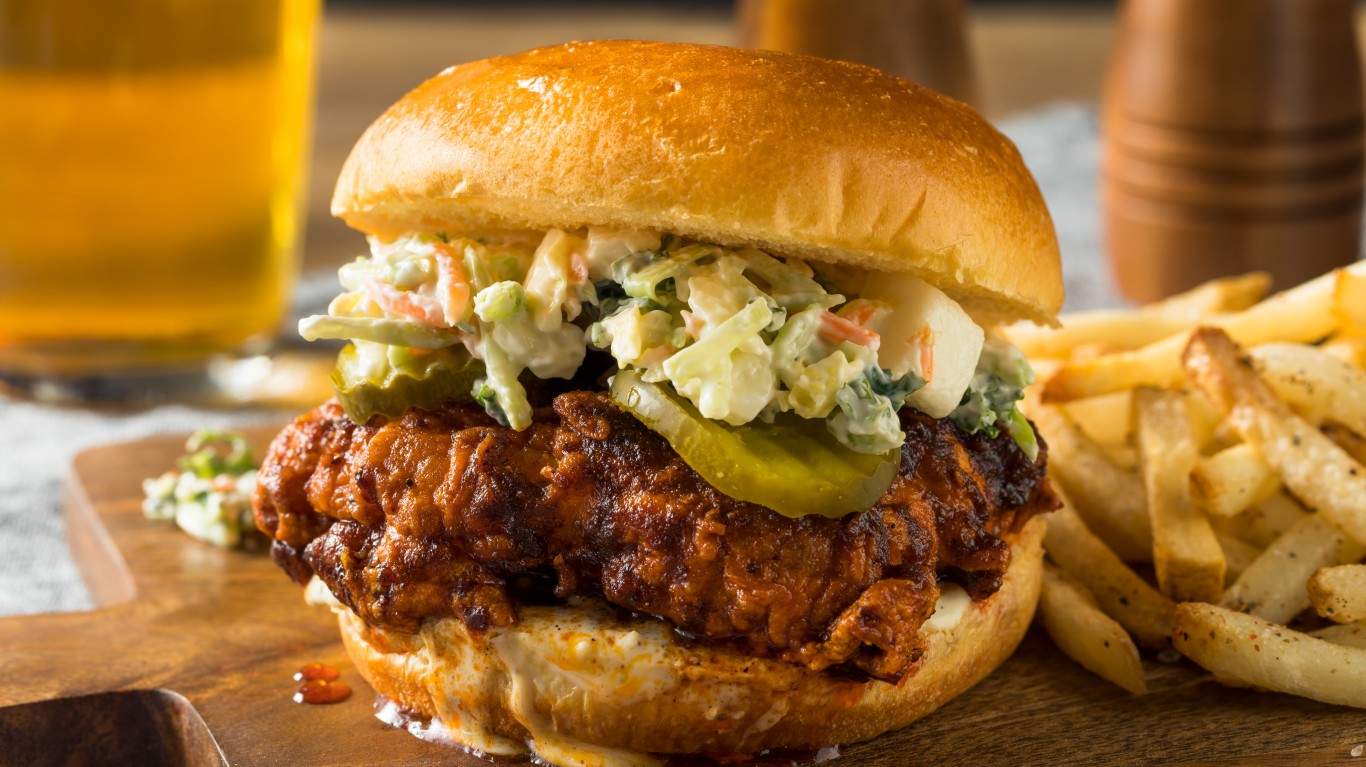
Nashville, Tennessee
> Signature: Hot chicken
Fried chicken with a spicy — sometimes very spicy — breading. According to legend, the dish has its origins in the 1930s, when a woman who had been wronged by a man-about-town named Thornton Prince sought revenge by serving him the spiciest chicken possible. To her dismay, he loved it that way and eventually opened the restaurant that became Prince’s Hot Chicken.

New Haven, Connecticut
> Signature: Pizza
Thin-crust pizza in the Neapolitan style, cooked in very hot brick ovens (sometimes coal-fired) to produce a signature char on the crust. The style started when Frank Pepe opened his Pizzeria Napoletana in 1925. His signature — and that of New Haven pizza in general — became the white clam pizza, topped with clams, garlic, parsley, and romano cheese.
[in-text-ad-2]

New Orleans
> Signature: Po’boy
A French bread loaf filled with anything from roast beef to fried shrimp, oysters, or other seafood, along with various condiments. Legend has it that the po’boy was invented by two New Orleans brothers in 1929 to feed striking streetcar workers (the “poor boys”). Other New Orleans signatures: muffuletta, a kind of Italian sub on a large round loaf, filled with Italian deli meats, cheese (usually provolone), olive salad, and sometimes pickled vegetables; beignets (fried yeast dough sprinkled with powdered sugar); gumbo (thick multi-ingredient stew in many varieties, thickened with okra or with filé — ground dried sassafras leaves).
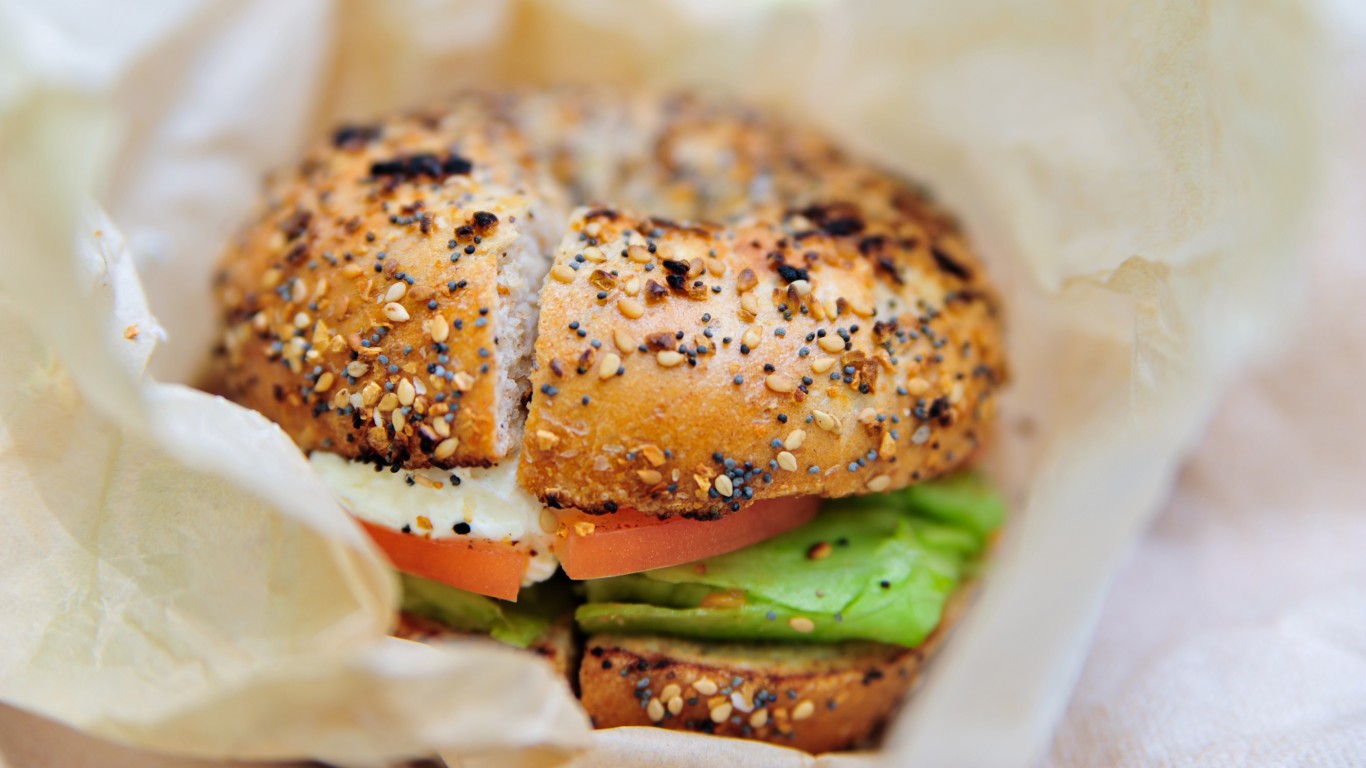
New York
> Signature: Bagel
A dense, chewy doughnut-shaped yeast roll whose dough is boiled before baking. First brought to New York’s Lower East Side by Polish Jewish immigrants in the late 19th century, bagels are now found everywhere in the city and far beyond, often made with various toppings (sesame or poppy seeds, for example) or variously flavored. The classic New York preparation is sliced, spread with cream cheese, and topped with lox (smoked salmon). Other New York signatures: “dirty water dogs” (a ubiquitous street-cart specialty of hot dogs pulled from a metal tub of warm water and served on a soft bun with various condiments); New York-style cheesecake, dense and creamy and much thicker than other varieties.
[in-text-ad]
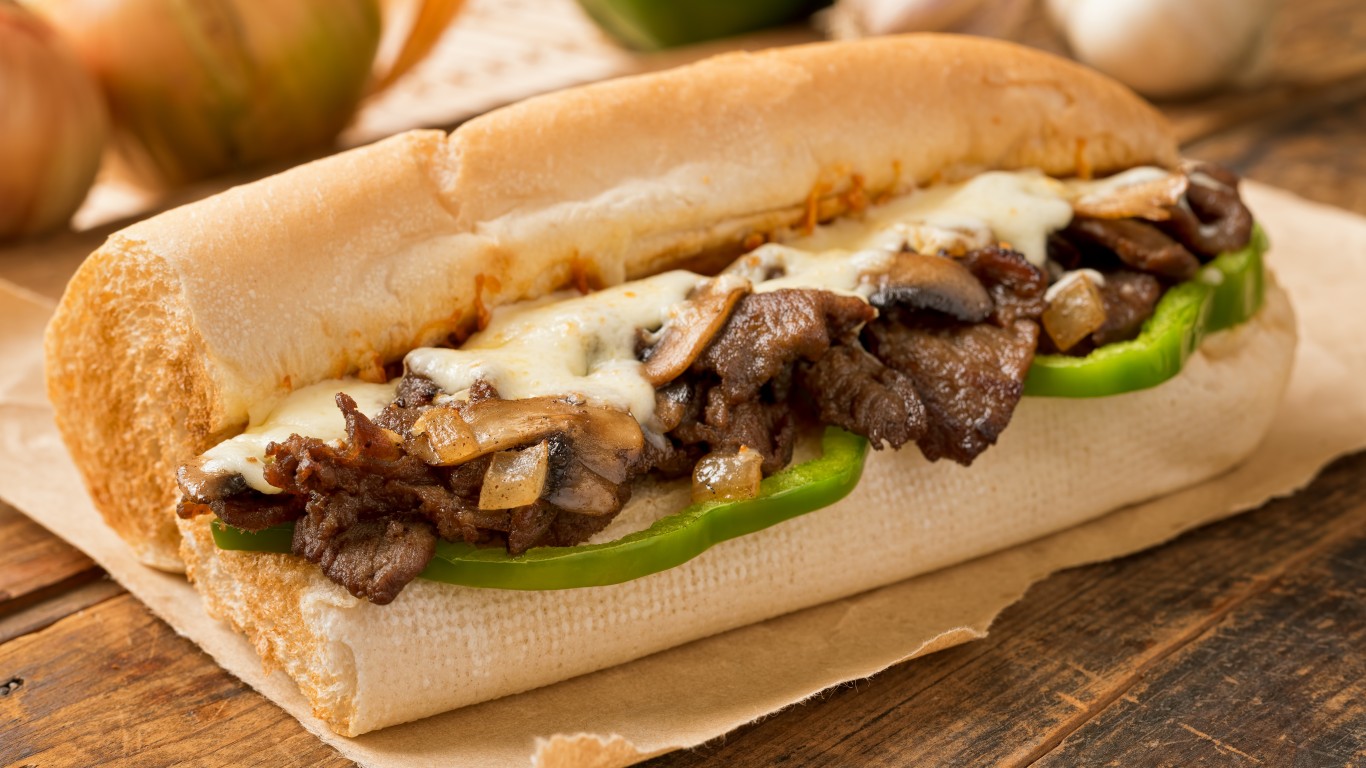
Philadelphia
> Signature: Philly cheesesteak
Thin-sliced beef and melted cheese on a submarine-style roll, with or without fried onions, mushrooms, and/or sweet or spicy peppers. The cheesesteak was invented in 1930 by a local hot dog vendor, Pat Olivieri — namesake of Pat’s King of Steaks, one of the city’s most famous purveyors of cheesesteaks to this day. Other Philadelphia signatures: roast pork sandwich (shaved or sliced pork, broccoli rabe, and provolone on an Italian roll); soft pretzels, served with mustard.

Portland, Maine
> Signature: Lobster roll
Cold lobster meat dressed with mayonnaise, sometimes mixed with scallions, chives, celery, and/or tarragon and served on a hot dog bun (sometimes the split-top kind). Maine is considered America’s lobster capital, and lobster rolls are found everywhere around the state.
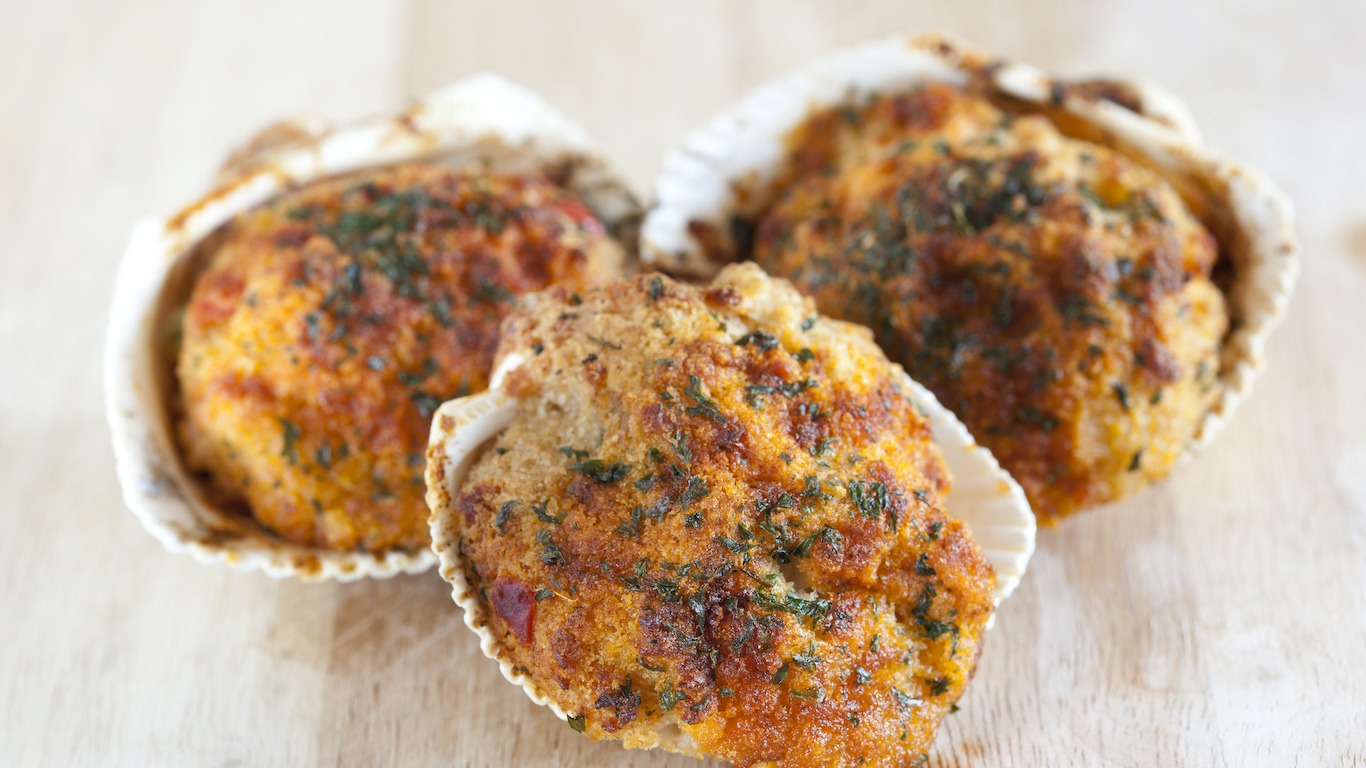
Providence, Rhode Island
> Signature: Stuffie
The chopped meat of large clams, usually the kind called quahogs, mixed with bread crumbs, chopped onions, celery, bell pepper, and herbs, then baked in the shell. The origin of stuffies is unclear, but quahogs became popular in the region only after 1938.
[in-text-ad-2]

Racine, Wisconsin
> Signature: Kringle
A flat, oval Danish-style pastry filled with nuts and sometimes fruit and glazed with icing. Kringles were introduced to Racine — which has been called “the most Danish city in America” — in the late 19th century by Danish immigrants. In Denmark, kringles are pretzel-shaped, and bakeries in that country traditionally depict one on their signs.

Rochester, New York
> Signature: The Garbage Plate
A plate heaped with meat (originally a couple of hamburgers) and side dishes, typically macaroni salad, home fries, and/or beans, served with bread or rolls and various condiments. The combination was invented by Alexander Tahou at his Rochester restaurant Hots and Potatoes — now called Nick Tahou Hots — in 1918. The name “Garbage Plate” was trademarked by the restaurant in 1992, but other Rochester eateries serve variations with other combinations of ingredients under such names as Dumpster Plate and Dog Dish.
[in-text-ad]
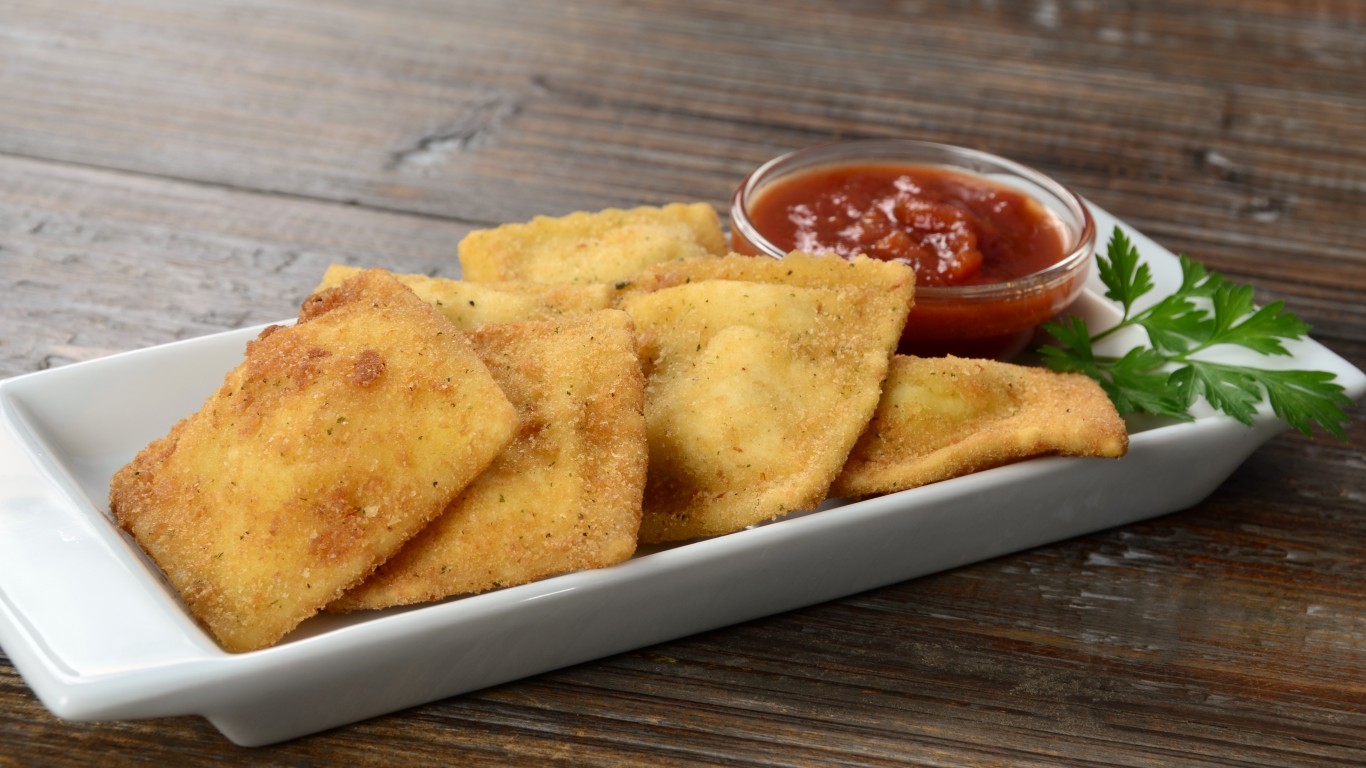
St. Louis
> Signature: Toasted ravioli
Ravioli with various fillings, coated in breadcrumbs and deep-fried — not toasted — then served with parmesan cheese and marinara sauce. The preparation is said to have been invented in the 1940s by a cook at Oldani’s restaurant. Proprietor Lou Oldani dubbed them “toasted” because, he once said, “You didn’t want to use ‘fat fried’ and you didn’t want to use ‘greasy fries.'” Other St. Louis signatures: Gerber sandwich, an open-faced sandwich of French bread topped with garlic butter, ham, and provel cheese (a white processed cheese native to St. Louis); gooey butter cake, a very rich, sugary, buttery yeast cake.
San Antonio, Texas
> Signature: Puffy taco
A crisp taco shell with various fillings made from fried raw masa dough that puffs up like funnel cakes. Conventional hard taco shells are made from tortillas that are lightly cooked first so they don’t puff up in the same way that raw dough does. This San Antonio specialty was invented at the city’s Ray’s Drive Inn in the 1950s.

San Diego
> Signature: Fish taco
Pieces of batter-fried fish on a tortilla with shredded cabbage or lettuce and various sauces. Originally from Baja California and possibly inspired by tempura dishes eaten by Japanese fishermen in Baja, the tacos were apparently first served to the public at Tacos Fénix in Ensenada in 1970. San Diego native Ralph Rubio first imported them to the U.S. in 1983.
[in-text-ad-2]
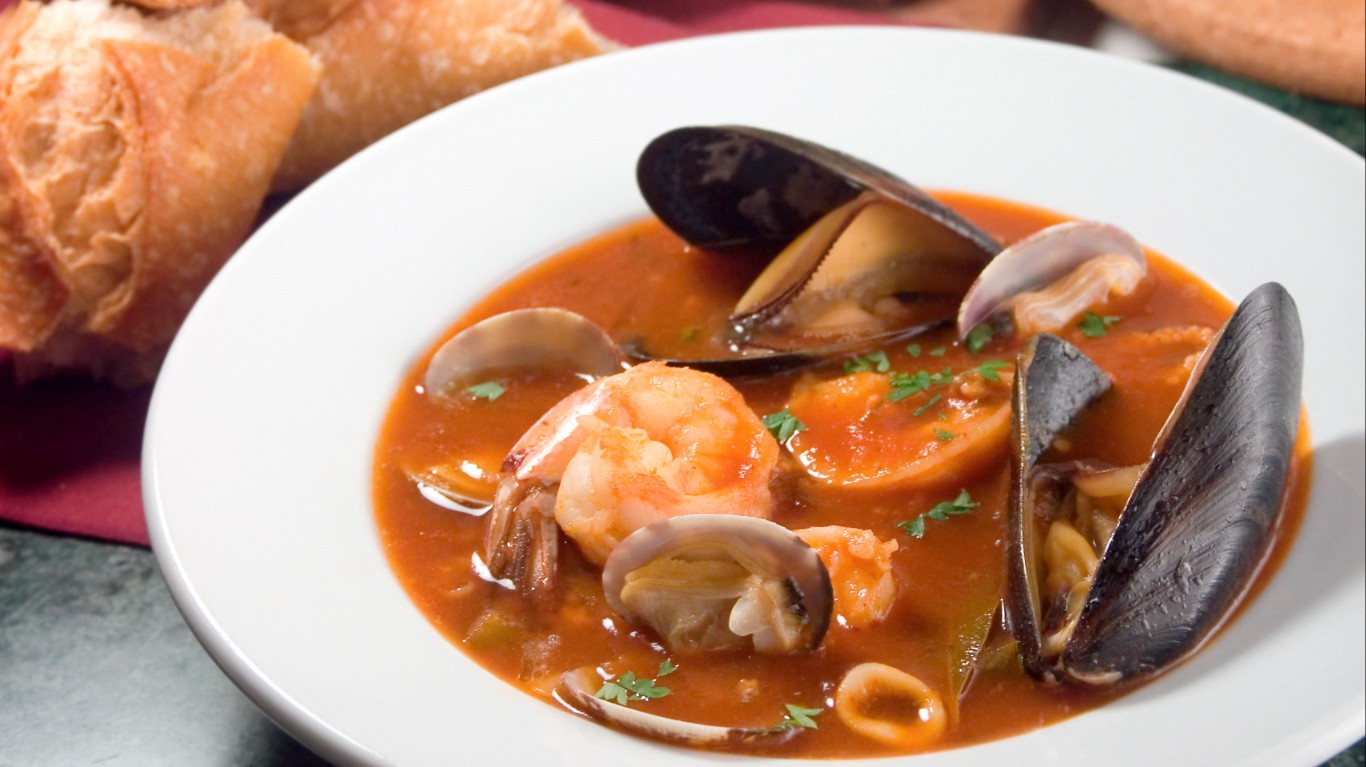
San Francisco
> Signature: Cioppino
A thick tomato-based fish and shellfish stew. Probably borrowing its name from the puréed Ligurian fish soup called ciuppin (many of San Francisco’s Italian immigrants came from Liguria), this hearty dish was developed by fishermen in the city’s North Beach neighborhood in the late 1800s, using whatever wasn’t sold from the day’s catch. Other San Francisco signatures: sourdough bread, dating back to Gold Rush days (the unique yeast strain responsible for its flavor is called L. sanfranciscensis); Mission burritos, overstuffed examples of the genre typically filled with rice, beans, meat, cheese, sour cream, guacamole, and salsa.
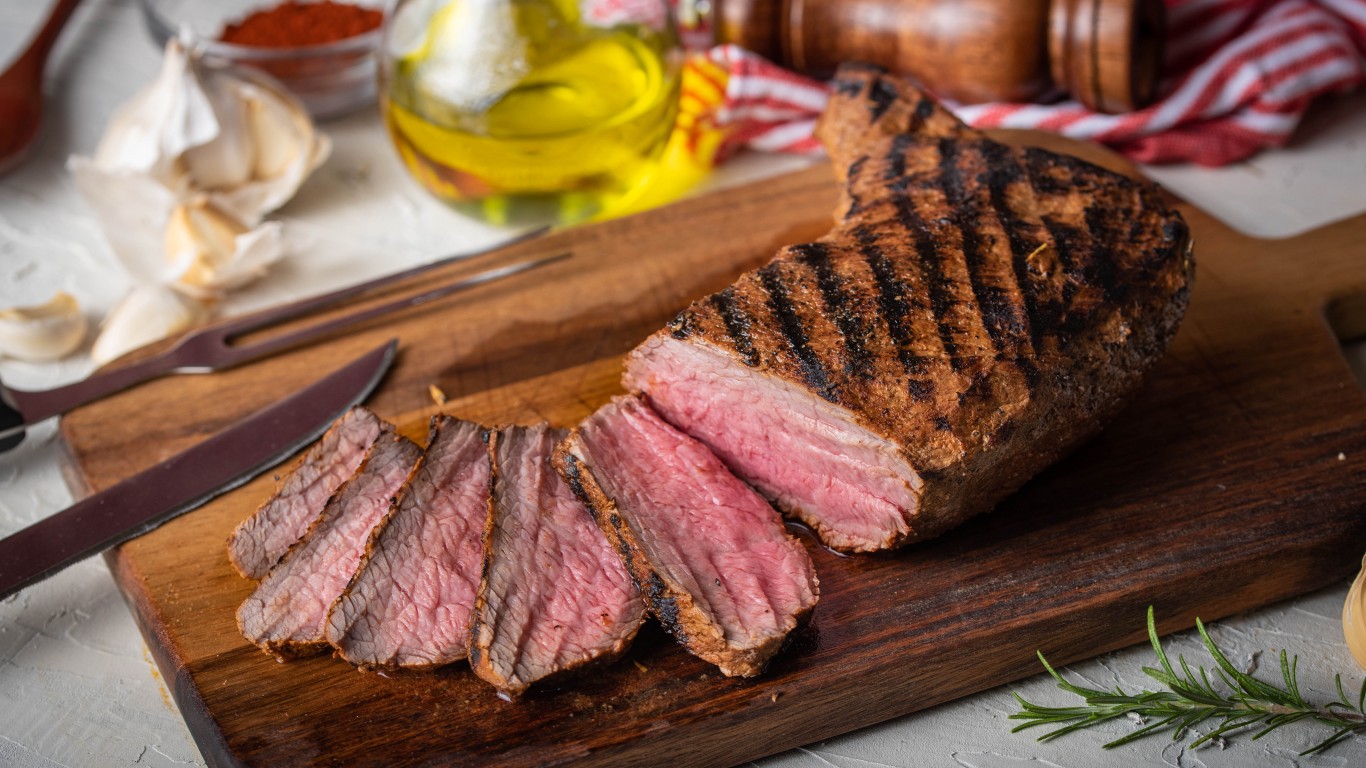
Santa Maria, California
> Signature: Santa Maria barbecue
Not a single dish but a meal consisting of grilled tri-tip or some other cut of beef served with beans, salad, garlic bread, and salsa. Though the meal, traditional in the region since the early 1930s, is called “barbecue,” the meat is cooked directly over hot coals, not long-smoked over indirect heat as with true barbecue. The beans are usually a variety called pinquitos, said to be native to the Santa Maria Valley.
[in-text-ad]

Sheboygan, Wisconsin
> Signature: Bratwurst
A mildly spiced pork and beef sausage, typically pan-fried or grilled. This German-style link, brought to eastern Wisconsin by German immigrants in the early to mid-19th century, was originally made with veal. When that meat became too expensive, pork and beef were substituted. The New York Times described Sheboygan as “the capital of the kingdom of bratwurst.”
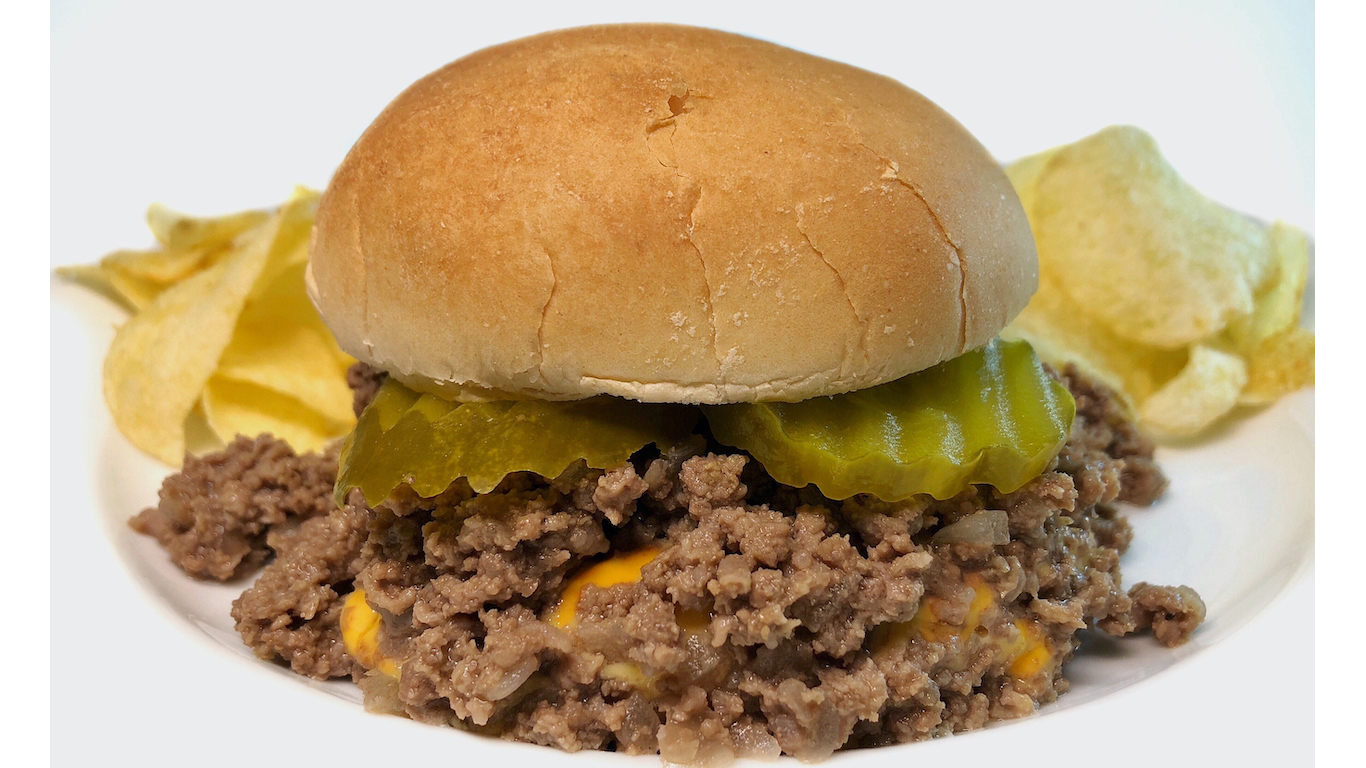
Sioux City, Iowa
> Signature: Loose meat sandwich
Crumbled burger meat cooked with chopped onion, served on a bun. often with pickles. Said to have been created in 1924 at Sioux City’s Ye Olde Tavern and sometimes called a tavern sandwich, it has been described as a sloppy Joe without the sauce. The Des Moines-based Maid-Rite chain, founded in 1926, is Iowa’s best-known purveyor of the sandwich.

Springfield, Illinois
> Signature:The Horseshoe Sandwich
An open-faced sandwich consisting of white toast topped with hamburger patties (originally slices of ham cut into horseshoe shapes), then strewn with French fries and napped in cheddar cheese sauce. It was created by the chef at Springfield’s now-defunct Leland Hotel in the late 1920s.
[in-text-ad-2]
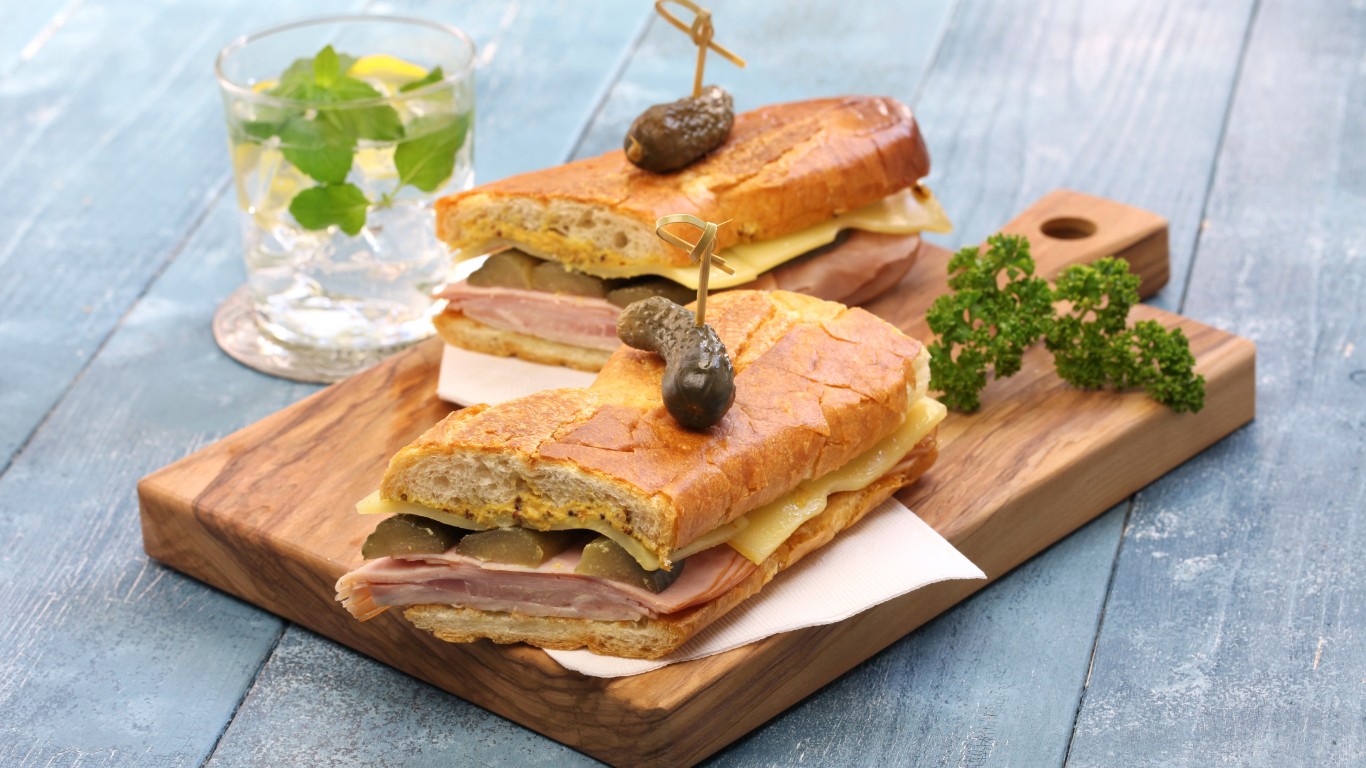
Tampa, Florida
> Signature: Cuban sandwich
Pork, ham, salami (sometimes), Swiss cheese, dill pickles, and mustard grilled on crusty Cuban bread. It doesn’t come from Cuba, but was developed by Cuban cigar factory workers in the Ybor City neighborhood of Tampa, Florida, probably in the late 1800s. The Tampa City Council dubbed it the city’s signature sandwich in 2012.
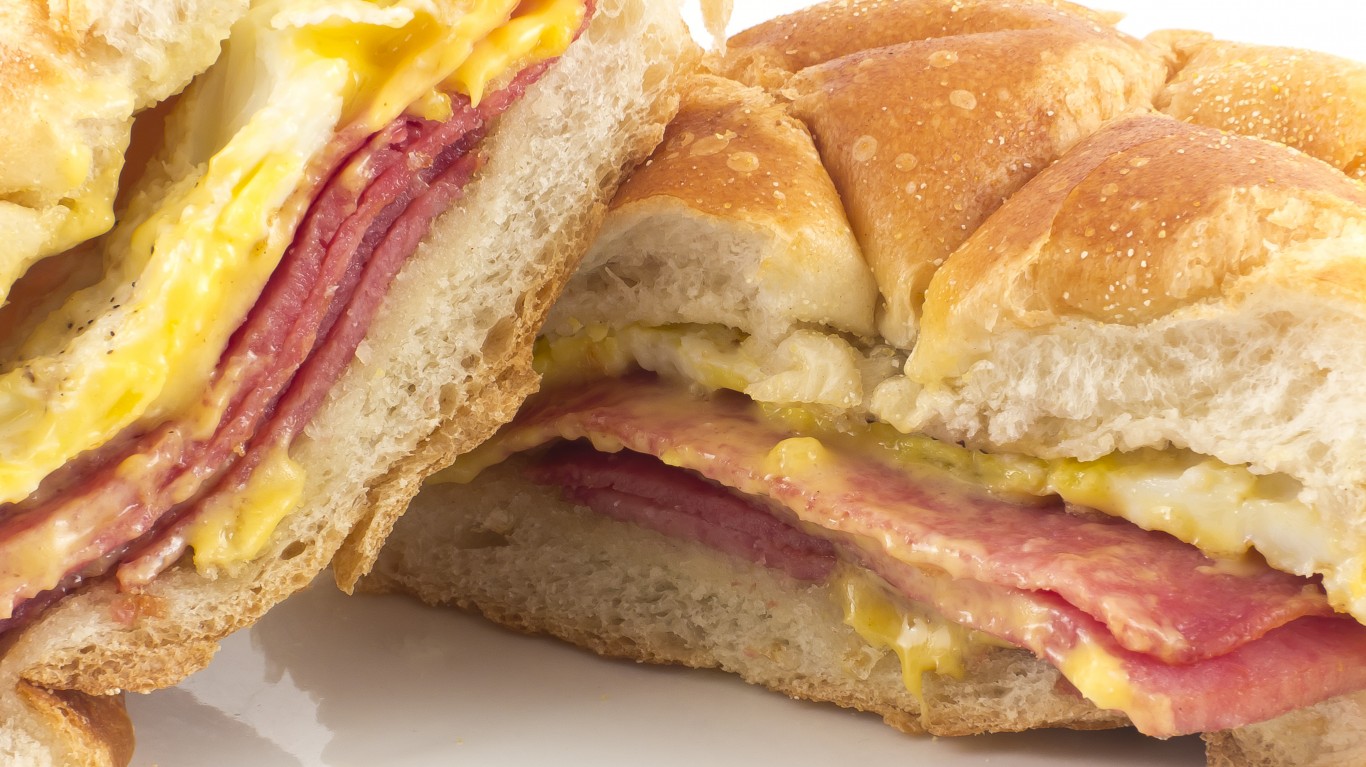
Trenton, New Jersey
> Signature: Pork roll
Processed pork-based breakfast and sandwich meat, somewhat similar to Spam or Canadian bacon, eaten sliced and fried or grilled. Invented by one John Taylor in Trenton in 1856, it was originally dubbed Taylor’s Prepared Ham, but because it didn’t fit the legal definition of ham, it was renamed John Taylor’s Original Pork Roll. In Trenton and elsewhere in northern New Jersey, it is still known as Taylor ham. Another Trenton signature: tomato pie, a pizza with the cheese and other toppings applied first and then covered with tomato sauce.
[in-text-ad]
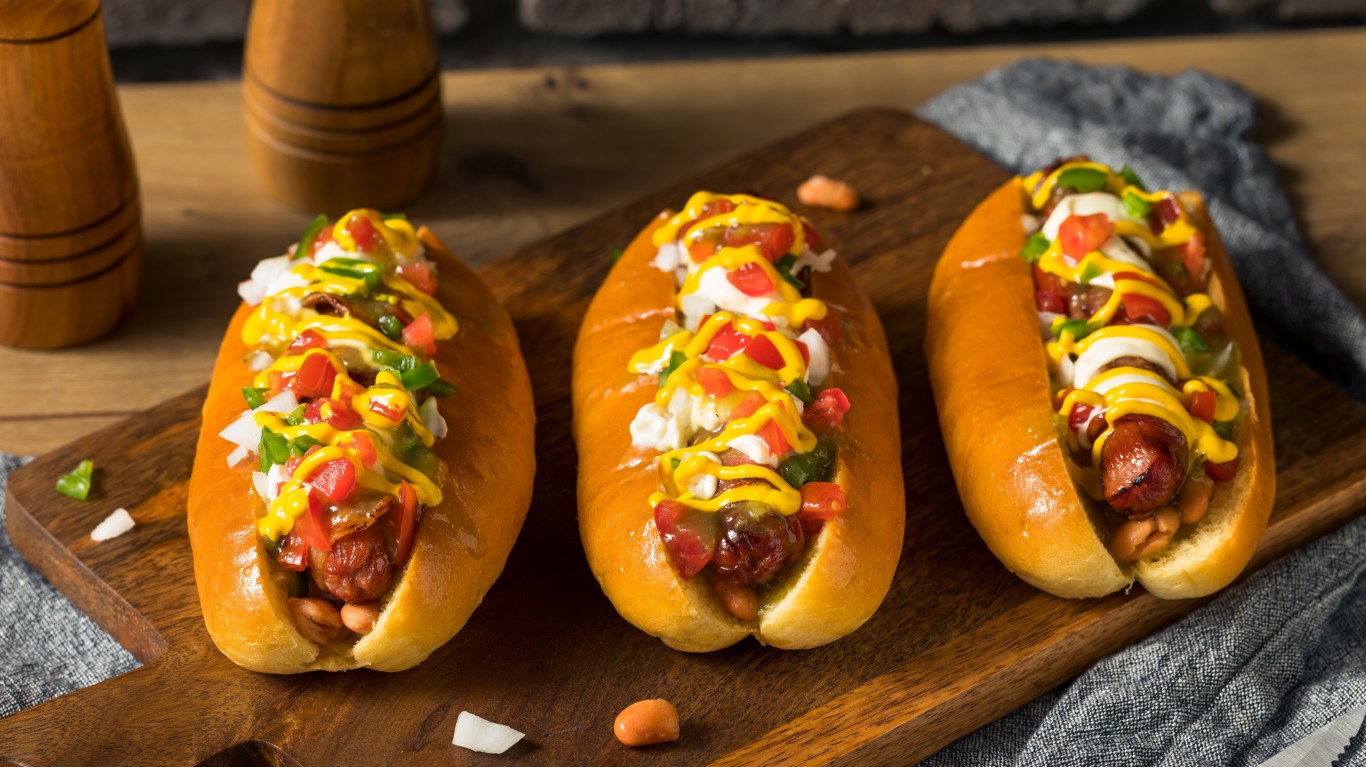
Tucson, Arizona
> Signature: Sonoran hot dog
A hot dog wrapped in bacon and covered with pinto beans, salsa, and sometimes other toppings and served on a split-top bolillo roll. Said to have come into Arizona from Hermosillo, capital of the Mexican state of Sonora, the dogs are now sold by as many as 200 “dogueros” all over Tucson. Another Tucson signature: chimichangas, large deep-fried burritos.

Utica, New York
> Signature: Chicken riggies
An Italian-American dish of rigatoni in a spicy, creamy tomato sauce with chicken added. No one is quite sure when and where the dish — also called Utica riggies — was invented, but it first appeared in the late 1970s or early ’80s, and one theory credits it to the Clinton House restaurant in nearby Clinton.
Washington D.C.
> Signature: Half-smokes
A spicy, smoky hot dog, usually made from a combination of coarsely ground pork and beef, typically served on a bun and topped with chili, cheese, and onions. Nobody knows how the sausage got its name, but it was first made by a meatpacking plant in Arlington, Virginia, and originally served for breakfast at that D.C. suburb’s Weenie Beenie stand. The capital’s famous Ben’s Chili Bowl restaurant, a favorite of President Barack Obama, is given credit for popularizing it.
[in-text-ad-2]

Winston-Salem, North Carolina
> Signature: Moravian chicken pie
Chicken and gravy — no vegetables — in a pie crust. Moravians — German-speaking Protestants originally from Central Europe — founded a settlement in what is now Winston-Salem in 1753. Chicken pie has been a staple of the community’s church suppers and bake sales there since about 1920.
Get Ready To Retire (Sponsored)
Start by taking a quick retirement quiz from SmartAsset that will match you with up to 3 financial advisors that serve your area and beyond in 5 minutes, or less.
Each advisor has been vetted by SmartAsset and is held to a fiduciary standard to act in your best interests.
Here’s how it works:
1. Answer SmartAsset advisor match quiz
2. Review your pre-screened matches at your leisure. Check out the advisors’ profiles.
3. Speak with advisors at no cost to you. Have an introductory call on the phone or introduction in person and choose whom to work with in the future
Thank you for reading! Have some feedback for us?
Contact the 24/7 Wall St. editorial team.
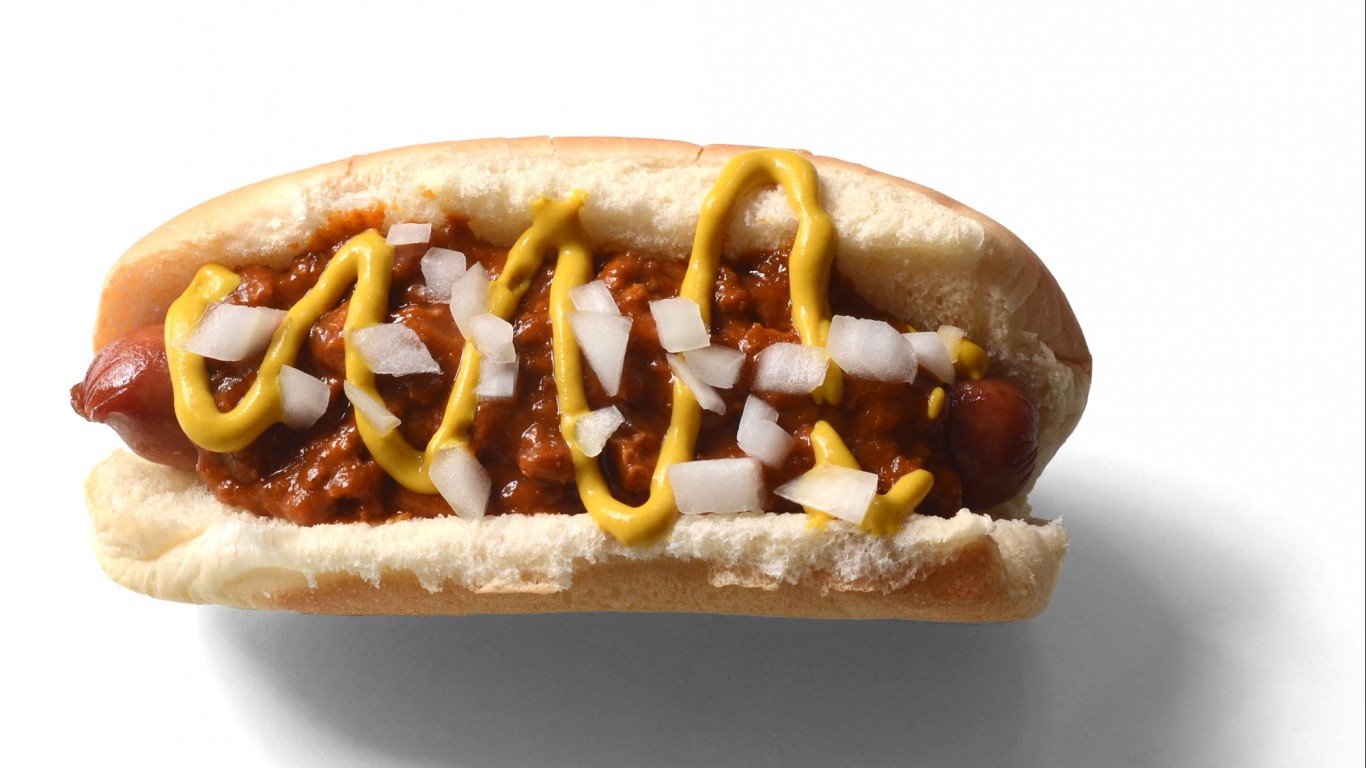
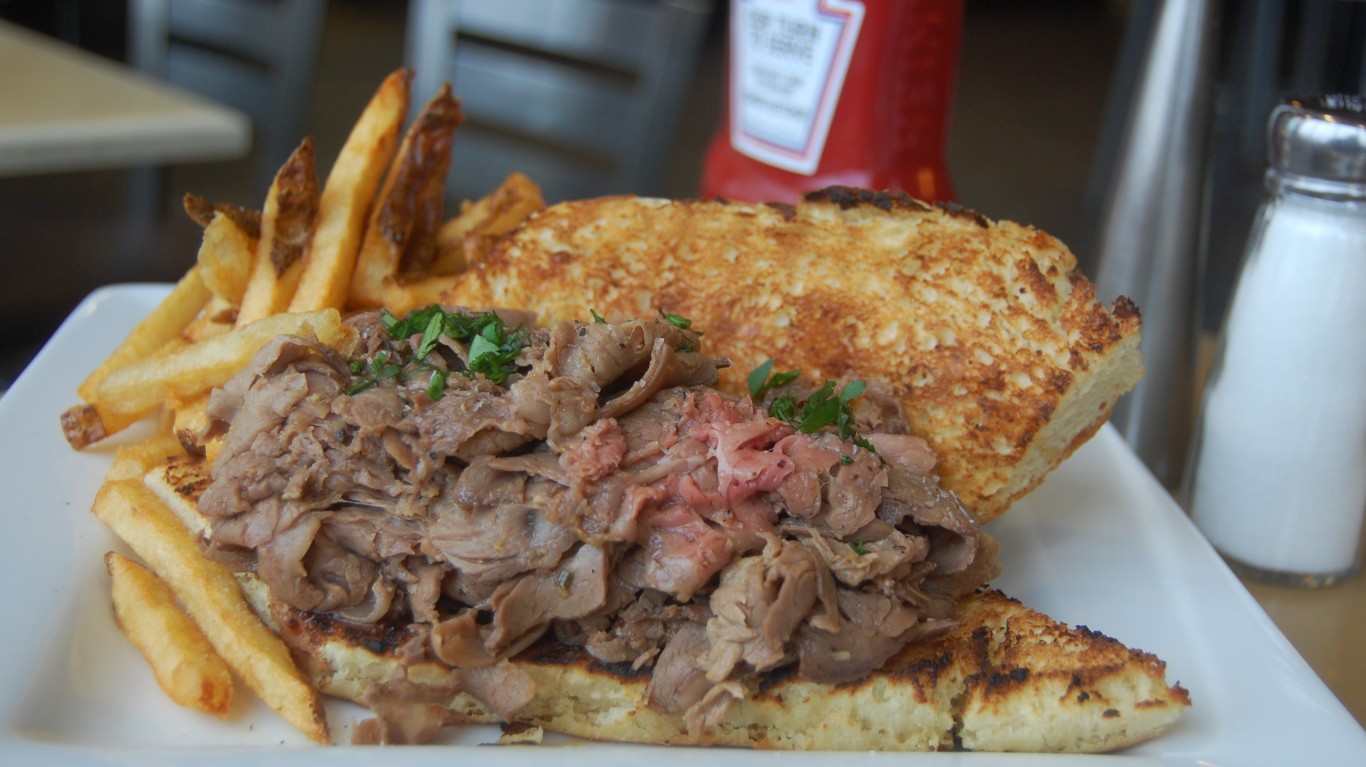
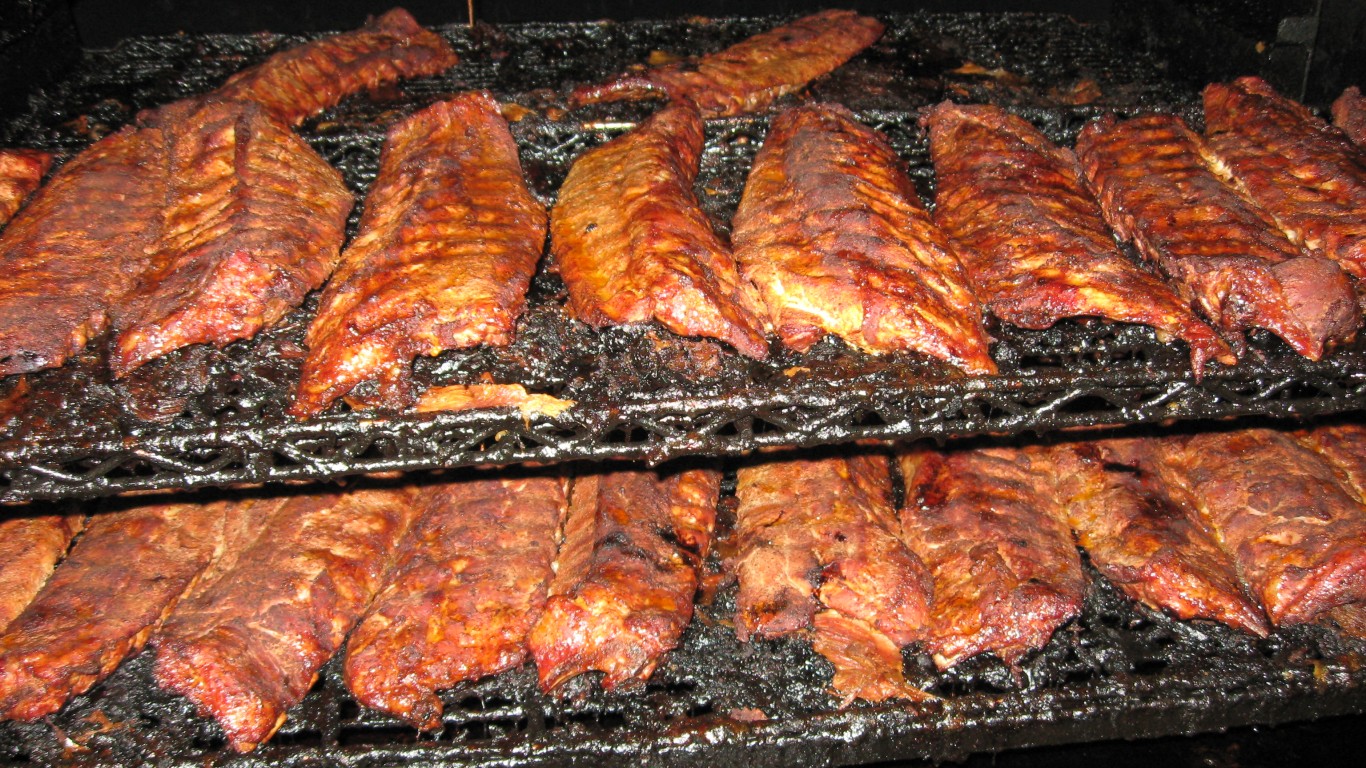
 24/7 Wall St.
24/7 Wall St. 24/7 Wall St.
24/7 Wall St.
 24/7 Wall St.
24/7 Wall St.